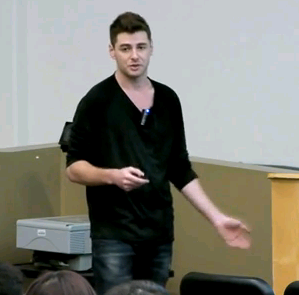UCI Chem 131C Thermodynamics and Chemical Dynamics (Spring 2012)
Lec 11. Thermodynamics and Chemical Dynamics -- Midterm 1 Review --
View the complete course: ../courses/chem_131c_thermodynamics_and_chemical_dynamics.html
Instructor: Reginald Penner, Ph.D.
License: Creative Commons BY-NC-SA
Terms of Use: ../info.
More courses at http://ocw.uci.edu
Description: In Chemistry 131C, students will study how to calculate macroscopic chemical properties of systems. This course will build on the microscopic understanding (Chemical Physics) to reinforce and expand your understanding of the basic thermo-chemistry concepts from General Chemistry (Physical Chemistry.) We then go on to study how chemical reaction rates are measured and calculated from molecular properties. Topics covered include: Energy, entropy, and the thermodynamic potentials; Chemical equilibrium; and Chemical kinetics. This video is part of a 27-lecture undergraduate-level course titled "Thermodynamics and Chemical Dynamics" taught at UC Irvine by Professor Reginald M. Penner.
Thermodynamics and Chemical Dynamics (Chem 131C) is part of OpenChem: ../openchem/
Recorded on April 25, 2012.
Index of Topics:
00:05 - Announcements
00:28 - Midterm Exam
00:52 - Partition Functions: Enjoy in any of Four Flavors...
01:51 - Example: The NO molecule has a doubly degenerate...
03:24 - Plot It:
05:01 - ...(b) the electronic contribution to the molar internal energy...
05:08 - Equations
05:22 - More Equations
05:38 - (Diagram) The electronic contribution to the molar internal energy...
06:32 - Here's a midterm exam question from a couple of years ago.
08:42 - Which equation(s) do I need?
10:31 - If you are asked: calculate the fraction of molecules...
10:48 - so what were we asked again? B. Now one mole of...
12:06 - The equipartition theorem:
13:33 - now you'll recall that the heat capacity...
14:15 - Formula: the equipartition theorem tells us...
14:17 - the equipartition theorem tells us that translation contributes...
14:41 - Graph: the contribution of molecular translation...
14:55 - Formula: ...this is also the heat capacity for all monoatomic gases
16:01 - For a linear molecule:
16:44 - Graph: translation + rotation
16:53 - For nonlinear molecule:
17:45 - ...well, let's go back to the classical Hamiltonian again.
18:12 - so following through with the predictions of the equipartition...
18:58 - Formula: in the specific case of a diatomic, we get:
19:02 - Formula Graph:
19:10 - Example: Use the equipartition theorem to estimate...
20:05 - Too subjective, let's use this rule of thumb:
Required attribution: Penner, Reginald Thermodynamics and Chemical Dynamics 131C (UCI OpenCourseWare: University of California, Irvine), ../courses/chem_131c_thermodynamics_and_chemical_dynamics.html. [Access date]. License: Creative Commons Attribution-ShareAlike 3.0 United States License.


